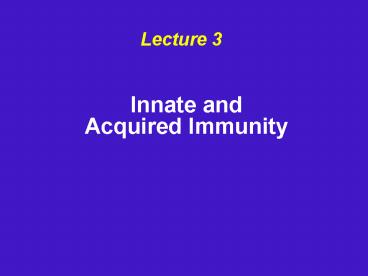Innate and Acquired Immunity PowerPoint PPT Presentation
1 / 36
Title: Innate and Acquired Immunity
1
Innate and Acquired Immunity
Lecture 3
2
Agenda
- Distinction between innate and specific immunity
- Discuss mechanisms of innate immunity
- Barriers
- Recognition of invading microorganisms
- Phagocytosis
- Inflammation
3
Innate Immunity
Specific Immunity
4
(No Transcript)
5
Innate Immunity
- Refers to various PHYSICAL, CHEMICAL, and
CELLULAR attributes that collectively represent
the first line of defense against infectious
disease.
6
Innate Immunity
- Natural Immunity
- Phylogenetically older Present in all
Multicellular Organisms - Use Proteins Encoded in the Germline (Elements an
Individual is born with Standard
Equipment-Hard-Wired
7
Innate Immunity Features
- Preformed Rapid-Available on Short Notice
- No MemoryNot Enhanced by Prior Exposure
- Broad Specificity
- Dependent on species, strain, sex.
8
Acquired/Specific Immunity
- Acquired Following Exposure to the Microorganism.
9
Acquired/Adaptive/Specific Immunity Features
- Specificity
- Memory
- Specialization
- Self/Nonself recognition
10
(No Transcript)
11
Innate vs. Acquired Immunity
- Innate/Natural/ Nonspecific
- present from birth
- operates against any substance
- not enhanced by prior exposure
- Acquired/Adaptive/Specific
- defense mechanisms tailored to individual
pathogens - enhanced by prior exposure
12
Mechanisms/Components of Innate Immunity
- Anatomic barriers
- Physiologic barriers
- Phagocytic/Cellular Barriers
- Inflammatory Barriers
13
Anatomic Barriers
- External/First line of defenses
- Epithelial Barrier
- Skin
- Mucous membranes
- Conjunctivae, GI, resp, urogenital tracts
- secretions (saliva, tears, urine, mucus)
- wash/trap/inhibit growth
- cilia
14
Functions of Epithelial Barrier
Defensins
15
Physiological Barriers
- Temperature-Fever
- pH-Stomach, vagina, and skin
- Normal microflora of GI tract, skin Superinfectio
n - Chemical Mediators
- Defensins-Secreted by Epithelia
- Hydrolytic enzymes of Saliva
- Lysozyme in tears
16
Physiological Barriers (Contd.)
- Interferons-viral infection
17
dsRNA
18
Cellular Barriers
- Following Penetration of Anatomical and
Physiological Barriers - Specialized Cells Function is to Destroy Invader
19
(No Transcript)
20
(No Transcript)
21
Recognition of Microbial Nonself
- Depends on recognition of Pathogen Associated
Molecular Patterns (PAMPS) - Gene products unique to microbes-Molecular
Signatures of microbial invaders - Conserved among microbes of a given
class-Invariant - Essential for microbial survival
- LPS (Gram negative bacteria) Peptidoglycan (Gram
positive bacteria)
22
Pattern Recognition Receptors (PRRs)
- Recognize PAMPs
- Receptors expressed on macrophages
- Signal to induce inflammatory cytokines and
activate host defense mechanisms - Examples
- Macrophage mannose receptor
- Macrophage Scavenging Receptor-LPS and Gram neg.
bacteria - Toll-like Receptors
23
Receptors of The Innate Immune System
24
TOLL-LIKE RECEPTORS
Unmethylated CpG DNA
LPS (G-ve)
Peptidoglycan (Gve) Zymosan (Yeast) Bacterial
lipopeptides
Flagellin
dsRNA
Bacterial Lipoproteins Parasite surface proteins
Viral ss RNA
TLR3
TLR8
TLR4
TLR2
TLR6
TLR9
TLR7
TLR1
TLR5
TLR2
25
Receptors and Responses of Phagocytes in Innate
Immunity
26
Phagocytosis
- Eating by Cells
- Ingestion/Engulfment and Destruction of Invading
Foreign Particles such as Bacteria - 1883 Metchnikoff
27
Professional Phagocytes
- Neutrophils
- Macrophages
28
Phagocytosis of Bacteria by Macrophages
29
Phagocytosis
- Adherence and Opsonization
- Ingestion
- Destruction
30
Opsonins and Opsonization
31
Adherence and Opsonization
- Adherence to Surface Receptors
- Mannose Receptor
- Scavenger Receptor
- Opsonins Greek- Prepare food for
- Enhance Phagocytosis
- Antibodies-Fc Receptors
- Complement Proteins-Complement Receptors
32
(No Transcript)
33
(No Transcript)
34
Resistant Pathogens
- Brucella abortus
- Listeria monocytogenes-Escape into the cytoplasm
- Mycobacterium avium, tuberculosis-cell wall lipid
prevents phagolysosome formation - Salmonella typhimurium
- Candida albicans
35
Evasion of Innate Immunity by Microbes
36
Inflammation
- Infection
- Injury
- Irritants

